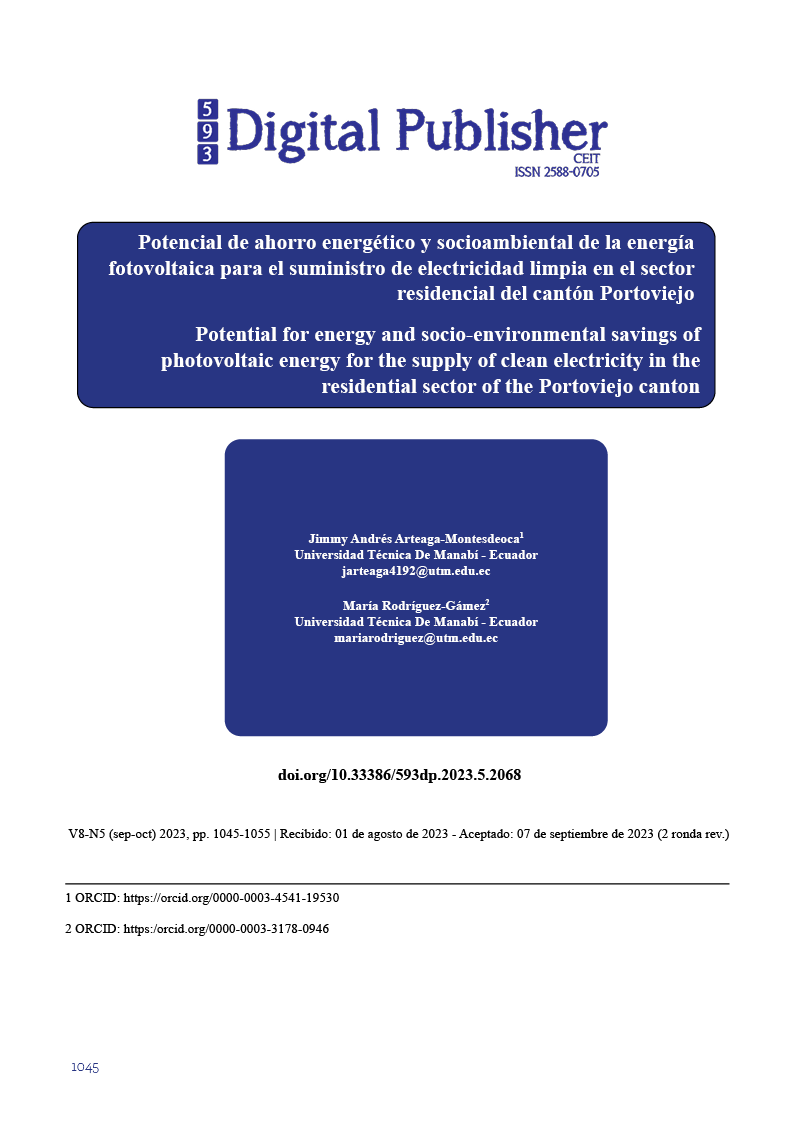Potential for energy and socio-environmental savings of photovoltaic energy for the supply of clean electricity in the residential sector of the Portoviejo canton
Main Article Content
Abstract
It is impossible to build a sustainable energy matrix on the foundations of traditional, costly and inefficient energy management. Political will is required for the transition of the energy matrix with renewable energy sources. The objective of the work is to provide the theories that are based on the use of solar energy, the preservation of non-renewable natural resources, the reduction of polluting gas emissions and the reduction of expenses associated with the payment of the electric bill of the Portoviejo canton.
Starting from the deductive paradigm, the review of the bibliographic material and primary information to design a qualitative investigation that, from the observation and examination of the problem, contributes elements for its solution, the interview was used with specialists of renewable sources who work at the Technical University of Manabí. As instruments, the QGIS is used, which is based on a geographic information system that allows an approach to the territory and the data related to solar potential, the PvSyst for simulations related to photovoltaic technology. The structure of the electrical system in the province is addressed, the situation of the supply of energy and the losses of the system, the solar potential and its use in the Portoviejo canton.
The technical, socio-environmental and economic feasibility for the introduction of photovoltaic technology in the self-consumption mode was obtained as a result, which achieves the integration of a more relocated, diverse, efficient territorial energy matrix and reduces environmental impacts. It is concluded that, with a 40% penetration of photovoltaic technology connected to the grid in the residential sector of Portoviejo canton, the equivalent of 229.9 GWh of clean energy can be provided annually for self-consumption and 41.4 GWh of energy losses can be avoided, thus avoiding the consumption of 57.5 tons of oil.
Downloads
Article Details

This work is licensed under a Creative Commons Attribution-NonCommercial-ShareAlike 4.0 International License.
1. Derechos de autor
Las obras que se publican en 593 Digital Publisher CEIT están sujetas a los siguientes términos:
1.1. 593 Digital Publisher CEIT, conserva los derechos patrimoniales (copyright) de las obras publicadas, favorece y permite la reutilización de las mismas bajo la licencia Licencia Creative Commons 4.0 de Reconocimiento-NoComercial-CompartirIgual 4.0, por lo cual se pueden copiar, usar, difundir, transmitir y exponer públicamente, siempre que:
1.1.a. Se cite la autoría y fuente original de su publicación (revista, editorial, URL).
1.1.b. No se usen para fines comerciales u onerosos.
1.1.c. Se mencione la existencia y especificaciones de esta licencia de uso.
References
Agencia de Regulación y Control de Electricidad [Arconel]. (2019). Estadística Anual y Multianual del Sector Eléctrico Ecuatoriano 2019. (Documento preliminar). Ecuador. https://www.regulacionelectrica.gob.ec/wp-content/uploads/downloads/2020/06/Est_2019_Borrador_08-06-2020_1606.pdf.
Agencia de Regulación y Control de Electricidad [Arconel]. (2020). Balance Nacional de Energía Eléctrica 2020. Ecuador. https://www.regulacionelectrica.gob.ec/balance-nacional/
Aguilar-Sánchez, Y. L., y Ortega-Castro, J. C. (2021). Aplicación de la guía PMBOK 6ta edición para la gestión de proyectos de sistemas de energía fotovoltaica, conectado a la red pública de servicio eléctrico. Caso: Granja avícola de la Provincia de El Oro, Ecuador. Domino de las Ciencias, 7(4), 706-728. https://dominiodelasciencias.com/ojs/index.php/es/article/view/2446.
Aguirre, N. (2019). Diseño de un sistema fotovoltaico Conectado a la red eléctrica pública para la IE N 16531, Puerto Chinchipe–San Ignacio. [Tesis de grado]. Universidad Nacional de Jaén Perú. https://core.ac.uk/download/pdf/270319112.pdf.
Bonilla, J. D. (2015). Evaluación de la oferta solar potencial para la producción de electricidad en zona rural del municipio de Sogamoso. [Tesis de grado]. Repositorio Institucional UDCA. Boyacá, Colombia. https://repository.udca.edu.co/handle/11158/415.
Geoportal (2023). Sistema de información geográfica SIGDS de la Universidad Técnica de Manabí. http://http://geoportal.utm.edu.ec//
Giraldo, M. Vaca, R., y Urrego, A. (2018). Las energías alternativas ¿una oportunidad para Colombia? Punto de vista, 9(13), 5. https://doi.org/10.15765/pdv.v9i13.1117.
Hernández, R. Fernández, C., y Baptista, P. (2017). Metodología de la Investigación 6ta edición. Ed. McGraw-Hill/Interamericana. México. https://www.uca.ac.cr/wp-content/uploads/2017/10/Investigacion.pdf.
Muñoz, Y. A. Acevedo, G. D., y Santamaría, J. D. (2019). Evaluación del potencial de energía solar en Santander, Colombia. Prospectiva, 17(2), 1. https://dialnet.unirioja.es/servlet/articulo?codigo=7047512.
Martínez, B. (2023). Identificación y evaluación de impactos ambientales en el desarrollo de una turbina hidrocinética tipo propela para la generación de energía eléctrica en zonas no interconectadas de Colombia. [Tesis de licenciatura]. Universidad de Medellín Colombia. http://hdl.handle.net/11407/7697.
Martínez, V. A. Rodríguez, M. Bravo, J. J. Vázquez, A. Valencia, J. A., y Bowen, C. (2019). Implementación de un Sistema de Información Geográfica para el Desarrollo Sostenible, en la Universidad Técnica de Manabí (Ecuador). Revista Espacios. Vol. 40 (Nº. 39). Pág. 26. https://www.revistaespacios.com/a19v40n39/19403926.html.
Pesantez, J. P. Ríos-Villacorta, A., y González-Redrován, J. (2021). Integración de Sistemas Solares Fotovoltaicos en el Sector Camaronero Intensivo y Extensivo del Ecuador: Caso de Estudio en la Provincia de El Oro. Revista Politécnica Vol. 47 Núm. 2. https://doi.org/10.33333/rp.vol47n2.01.
PvSyst. (2018). PVSyst V6.43. PREMIUM. Programa informático para diseño de sistemas fotovoltaicos. htpp//www.pvsyst.com.
Rodríguez, B., Fernández, M., y Fernández, N. (2014). Análisis del ciclo de vida de la generación distribuida en Cienfuegos. Ingeniería Energética, 35(3), 274-285. http://scielo.sld.cu/scielo.php?script=sci_arttext&pid=S1815-59012014000300012.
Rodríguez, M., y Vázquez, A. (2018). La Energía Solar en la Provincia de Manabí. Ed. UTM. Manabí Ecuador. https://www.researchgate.net/publication/328052221_LA_ENERGIA_FOTOVOLTAICA_EN_LA_PROVINCIA_DE_MANABI.
Rodríguez, M., Vázquez, A. Castro, M., y Vilaragut, M. (2013). Sistemas fotovoltaicos y la ordenación territorial. Ingeniería Energética, 34(3), 247-259. https://www.redalyc.org/pdf/3291/329128758008.pdf.
Santos, R. D. Gerard, H. Fernández, M. C., y Acosta, B. H. (2012, May). Sistema fotovoltaico conectado a la red eléctrica, su diseño. In presentado en II Congreso Cubano de Ingeniería Eléctrica, La Habana, Cuba.
Scull, Y. (2014). Evaluación de la penetración fotovoltaica en uno de los nodos de la microrred Naranjito. [Tesis de grado]. Centro de Investigación y Pruebas Electroenergéticas (CIPEL). Instituto Superior Tecnológico José Antonio Echeverria, La Habana Cuba. https://www.gestiopolis.com/wp-content/uploads/2015/08/trabajo-de-diploma.pdf.
Urbina, E. C. (2020). Investigación cualitativa. Applied Sciences in Dentistry, 1(3). https://doi.org/10.22370/asd.2020.1.3.2574.

